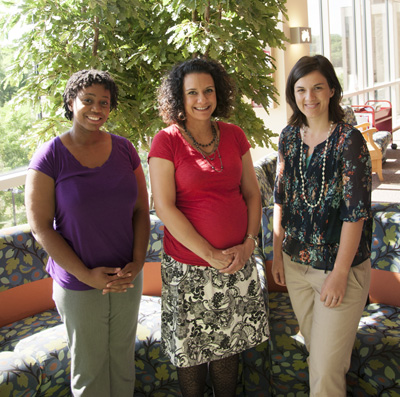Third-year medical student Jasmine Zapata was a little nervous before her pediatrics clerkship. Not because she thought it would be too challenging, but because it might not be challenging enough.
“I knew the inpatient part would be exciting, but thought the outpatient part would be just a lot of runny noses and ear infections,” she recalled. “But I hoped for the best.”
Fortunately for Jasmine, “the best” ended up being some of the most rewarding and defining experiences of her nascent medical career.
General to Specialty Care, Inpatient and Outpatient Settings
What’s unique about the pediatrics clerkship is that it offers students clinical experiences in both general and specialty pediatrics, through three weeks each on inpatient and outpatient services.
“We’re really preparing medical students to go into any facet of pediatrics,” said former clerkship director Gwen McIntosh, MD, MPH. “Six weeks is a short time, so we want to teach students as much as possible, but also get them really excited about the specialty.”
Angela Veesenmeyer, MD, MPH, who took over as director on June 1, 2012, added that through the clerkship, medical students receive valuable exposure to the multidisciplinary model of care.
“We show medical students how a team of providers—primary care and specialty physicians, social workers, health psychologists, child life specialists, and case managers—work together to focus on and coordinate all aspects of a child’s care,” she said.
Dr. McIntosh and Dr. Veesenmeyer agree that the breadth of the clerkship, and the excellent teaching by faculty and residents, makes it one of medical students’ top-rated experiences of their clinical years.
Diversity with Continuity

Just ask third-year medical student Heather Lukolyo. During her clerkship, she experienced “all that pediatrics has to offer”: minutes-old newborns in the neonatal intensive care unit, children needing specialty care in the cardiology and endocrinology clinics, adolescents in the general pediatrics clinic, and acutely ill children in the Pediatrics After Hours Clinic.
“It’s a lot for six weeks, but we work with certain providers multiple times, so they get to know you and trust you,” she said. “It’s a really diverse experience, but not so much that every day you’re meeting a different set of people and having to introduce yourself all over again.”
That continuity extends to the inpatient portion of the clerkship. For example, Heather was able to complete a shift in the emergency department, and then follow some of those same patients later on the hospital floor. “It was rewarding to watch patients improve day-to-day on the floor, and eventually see them discharged home,” she recalled.
She also participated in Family-Centered Rounds, another experience unique to the pediatrics clerkship. In Family-Centered Rounds, the medical team rounds inside patients’ rooms, engaging children and their families in a two-way discussion.
“The team really allowed medical students to lead those interactions,” she said. “It enhanced my communication skills with families, and forced me to explain things in a more understandable fashion while still presenting all the pertinent medical information.”
Heather, who earned a master of public health and worked in Uganda before entering medical school, isn’t completely sure of her future career plans, although she says they will include aspects of primary care and international health.
But, as she said, “Seeing so many different sides of pediatrics got me excited about the specialty and all of its opportunities, should I choose that route.”
Career-Defining Experiences
For Jasmine, however, several clerkship experiences helped set her path to pediatrics in stone.
While on service in the emergency department, a young boy was brought in unresponsive after an accident. She accompanied the attending physician as he explained to the family that the boy wasn’t likely to survive. Later, she was able to spend more time with the family, including the boy’s older sister, in the pediatric intensive care unit—despite not being on that service that day.
It was a watershed moment for Jasmine, whose own younger brother had died five years ago. “I hadn’t had to relive that since he died, and didn’t know if I was strong enough to handle it yet,” she recalled. “It was really scary, but I’m glad I did it.”
“One of the reasons people may not want to go into pediatrics is because sometimes, kids die,” she continued. “But going through that—and being able to use my own life experience—confirms that I want to be that person who can give comfort to families, even in the saddest of situations.”
Jasmine’s concern about “runny noses and ear infections” also turned out to be unfounded. During her outpatient experience, she had rewarding encounters with newborns at well-baby checkups, children undergoing post-hospitalization follow-ups, and teenagers asking about birth control.
Through relationships with several faculty mentors, she also saw how pediatricians in the outpatient setting develop deep relationships with their patients.
“It was so dynamic, we saw so much, and I realize how important outpatient providers are,” she said. “In fact, if I had to choose today, I would focus on outpatient. This rotation made that a strong possibility.”